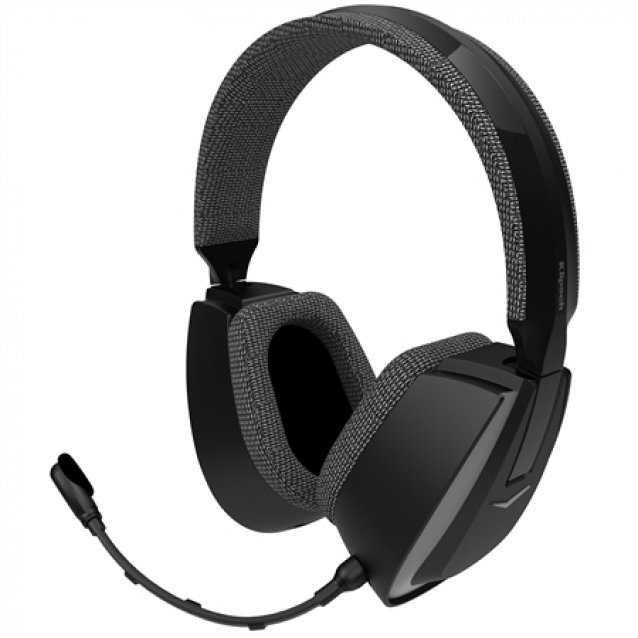

Klipsch's KG-300 gaming headset advertises all the right features for a modern set of cans. It offers wireless versatility on the Xbox 360, Xbox One, PlayStation 3, PlayStation 4 and PC with Dolby Digital decoding and virtual surround provided by Klipsch's own SphereSpace technology. A number of equalizer, audio and chat options are all customizable from nearby ear cup controls. It also proclaims "legendary sound" and a "great fit," honed by over 60 years of industry experience. But what's exciting on paper unfortunately doesn't translate to the same level of excitement in practice.
 The KG-300's setup is fairly typical for a wireless headset. An included transmitter connects to your primary devices via optical and USB cables. Three triple-A batteries power the headset itself, likely a result of its multi-platform support, but you'll still need to connects its 3.5mm chat cable if you want to socialize with Xbox 360, Xbox One or PlayStation 4 friends.
The KG-300's setup is fairly typical for a wireless headset. An included transmitter connects to your primary devices via optical and USB cables. Three triple-A batteries power the headset itself, likely a result of its multi-platform support, but you'll still need to connects its 3.5mm chat cable if you want to socialize with Xbox 360, Xbox One or PlayStation 4 friends.
The transmitter is a hand-sized chunk of black plastic. Auxillary volume controls rest on its top. A mode button between them cycles chat functionality by device. LEDs below indicate whether Dolby decoding and Klipsch's Spherespace Surround are active or not. A welcome inclusion not seen too often is a passive headphone out jack toward the front to allow an additional person to hear game audio. Furthermore, a vertical stand can be attatched near the back for easy headset storage.
Similar plastic makes for most of the KG-300 headset, of which I wouldn't advise bending or dropping too strongly. The tear-shaped ear cups complimented with the gray and black mesh earpads and headband do make for a rather unique presentation, however. If nothing else, I applaud its defiant, cool character in a crowd abundant with ovality.
Sadly, it's hard to give applause to it for comfort. Not only was the headset slightly too large for my average-sized head, wearing it was akin to battling lobsters pinching at the ears. The KG-300 drained my lobes of color as soon as I put it on. That pressure was only bearable while wearing the headset over a hoodie. I can only surmise it was squeezing my life energy for some nefarious purpose, blood swirling inside the vampiric cups as fuel for its dark rituals, or that the engineers at Klipsch sport luxurious, thick heads of hair that act as natural cushions. They're the only explanations.
 The audio controls on the right ear cup required a minor ritual of their own to figure out, though thankfully not one of blood. Six buttons handle game, chat and global volume, EQ presets, self voice monitoring and muting depending on whether they're pressed or held. They're large enough so as not to confuse them, but feedback isn't always obvious as to what's been input. Beeps are the only clue that anything's changed, which isn't wholly helpful if you don't remember the order of presets or when it decides not to produce the noise at all. Maybe I've just been spoiled by the voice in a recent Turtle Beach headset that audibly relayed my adjustments. In any case, it's a small complaint that's resolved easily enough by keeping the owner's manual within reach.
The audio controls on the right ear cup required a minor ritual of their own to figure out, though thankfully not one of blood. Six buttons handle game, chat and global volume, EQ presets, self voice monitoring and muting depending on whether they're pressed or held. They're large enough so as not to confuse them, but feedback isn't always obvious as to what's been input. Beeps are the only clue that anything's changed, which isn't wholly helpful if you don't remember the order of presets or when it decides not to produce the noise at all. Maybe I've just been spoiled by the voice in a recent Turtle Beach headset that audibly relayed my adjustments. In any case, it's a small complaint that's resolved easily enough by keeping the owner's manual within reach.
Its sound quality initially fared much better. Bass is deep, if not a little overpowering, and rocks the head with every gun shot and explosion. The virtual surround sound proved quite accurate. The screams of zombies in Dying Light were easy enough to pinpoint as I vaulted by the hordes. I did hear some hissing when audio was quiet, a trait I've found that to be fairly common with non-passive headsets or ones featuring additional processing, but the KG-300 handled this better than most. It was almost imperceptible were I not listening for it.
In a turn of events, those good qualities quickly fell apart as soon as I connected the 3.5mm chat cable so as to converse with friends. Loud, clear audio transformed into muffled and distant. The virtual surround effect was difficult to discern despite still being enabled. It simply lacked any measure of life, even as I increased the volume in attempts to compensate. More confounding was its insistence on turning itself off at regular, timed intervals. Fresh batteries did nothing to alleviate that condition. The problem never occurred without the chat cable.
"Legendary sound" and a "great fit" are the two most important characteristics that define a good headset. To my disappointment, neither could apply to the Klipsch KG-300. And $230 dollars is simply too much to ask for "hollow sound" and "I can't feel my ears anymore."




 GTA 5: Locations of all Humans / Characters of Los Santos
GTA 5: Locations of all Humans / Characters of Los Santos 13 Awesome Gifts for the IT Support Person in Your Life
13 Awesome Gifts for the IT Support Person in Your Life I Promise Steam Early Access Isn't Ruining Gaming [Opinion]
I Promise Steam Early Access Isn't Ruining Gaming [Opinion] PS4: Play Videos / Music from USB device or DLNA connection
PS4: Play Videos / Music from USB device or DLNA connection GTA V PC Cheat Codes For Invincibility, Max Health and Armor, Wanted Level, Spawn Vehicles, World & More: Updated
GTA V PC Cheat Codes For Invincibility, Max Health and Armor, Wanted Level, Spawn Vehicles, World & More: Updated